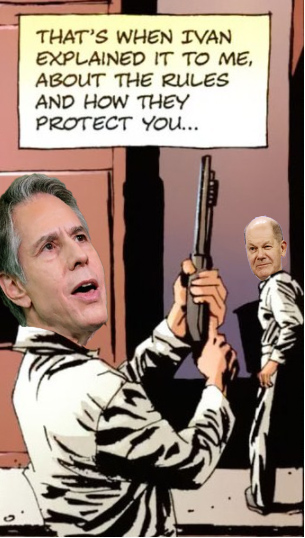

By John Helmer, Moscow
@bears_with
How to stop the US provocations aimed at pushing Russia to go to war in the Ukraine, and at claiming credit for deterring Russian from doing so? Impossible – the US cannot be stopped. But Germany, the country most likely to suffer the direct effects of war in the Ukraine, can stop the American deployment of nuclear-capable weapons on Ukrainian territory.
Will the war start? Silly question – the war won’t start because it has already started, and has been in active use-of-force mode since February 2014 when the US overthrew the Kiev government of President Victor Yanukovich; attempted to take Russian bases in Crimea; and followed in July of that year with the plot to down Malaysia Airlines flight MH17 and trigger a NATO invasion of the Donbass.
Right now on the Ukraine front, Russia will do nothing new; that’s to say, nothing more than it has already done, and is doing. But if and when Germans agree to the Americans deploying nuclear-capable weapons on Ukrainian territory, as they have already done in Romania, Poland, and the Black Sea, then the Stavka in Moscow will do something no western intelligence agency, think-tank, propagandist, and least of all the Japanese mouth organ known as the Financial Times will have anticipated.
For the time being, the Russian assessment is that the US will not make war against Russia directly because it is divided between the Americans who are reluctant, of whom President Joseph Biden is one; CIA director William Burns another; Defense Secretary Lloyd Austin and General Mark Milley, Chairman of the Joint Chiefs of Staff, two more. Gung-ho by contrast are Secretary of State Antony Blinken (lead image, left) and Victoria Nuland, Under Secretary of State — the Blin-Needle* gang who are quite recent Americans; their grandparents were Ukrainians. The Russian assessment is that their anti-Russian violence is in part the outcome of their relatively recent capture of state position. For the past three generations, and longer, the Blin-Needle gang has been hating and under-estimating the Russians; they think they have made their successful careers, advancing themselves to the top of the US state, by doing so.
Under-estimating the Russians was a mistake the advancing German army commanders made during the first wave of their invasion eighty years ago. They don’t make the same mistake today.
The Russian tactic, therefore, is to try publicly differentiating the Blin-Needle gang from Biden, Burns, Austin, and Milley in Washington, and from the new German leadership in Berlin of Olaf Scholz (lead image, right). Their coalition can hold together so long as they can keep their proxies – the Ukrainians, Romanians and Poles – on a short leash. Taken together, or separately, these three national groups present no serious risk of war the Kremlin isn’t confident of managing in the short or medium term.
The war problem becomes immediate and much more difficult to manage if and when the US moves its own forces with nuclear-capable weapons into firing positions in these front-line states, in the skies above, and on the Black and Baltic Seas.
Over the evening and early morning of June 21-22, 1941, when German forces were launching their Operation Barbarossa, the invasion of the Soviet Union, the German Foreign Minister Joachim von Ribbentrop, summoned the Soviet ambassador in Berlin, Vladimir Dekanozov, to tell him the “serious threat represented by Russian troop concentrations on Germany’s eastern frontier have compelled the Reich to take military counter-measures.” On Dekanozov’s way out, von Ribbentrop also whispered: “Tell them in Moscow I was against this attack.”
In Moscow the German ambassador Count Fritz-Dietlof von der Schulenberg was summoned to the Soviet Foreign Minister, Vyacheslav Molotov, and delivered Germany’s declaration of war. It is recorded there were tears in his eyes. Von der Schulenberg said he thought the decision to invade was madness. On November 10, 1944, von der Schulenberg was hanged for his part in the assassination plot against Adolf Hitler of that year. Two years later, on October 16, 1946, von Ribbentrop was hanged for war crimes and crimes against humanity. There is this risk for state officials who go to war with Russia.
In the present situation on Russia’s western fronts, the lines beyond which the US, Germany and Russia will be at war directly, are not new. These red lines have been spelled out repeatedly since President Vladimir Putin’s cross-hairs warning of May 2016 in Athens.
Greece was not an accidental choice for that warning. This is because the Greek government has now reversed the decision of Andreas Papandreou’s government between 1982 and 1989 not to allow secret treaty provisions for the US to store nuclear warheads at Greek bases, and to conceal US Navy missile-firing exercises in the Greek islands. The nuclear missiles which US warships may now carry into the Black Sea to launch at Russia may be loaded at the Rota base in Spain, or the Souda base in Crete.
How close to Russian targets the Biden Administration has decided to move up these weapons, and with what operational orders, has been the principal objective of Russian meetings with the Americans since the inauguration in January. The deployments have been the explicit focus of the talks between Putin and Biden, and between the Russians and Blinken, Nuland, Burns, Austin, and Milley. Austin is the only ranking US official not to have met his Russian counterpart, Defence Minister Sergei Shoigu, face to face. Between Austin and Shoigu there has been just one telephone-call on August 11. The political significance of that is unreported in Washington.
The decision of the Russians to release their summary of positions in these talks in the form of two draft treaties, one for the US and the second for NATO, makes public for everyone to read, especially in Europe, precisely what has been discussed and how little has been agreed in the secret discussions with US officials to date. That there are two pacts, not one, is principally a signal to the new German coalition government; and also to the collapsing pre-election coalition in France.
That direct nuclear war is imminent between Russia and the US, and in Europe, is the explicit point of the two documents. In the proposed US treaty, the Russians have introduced this as the concept of the “core security interest”, which is repeated in Articles 1 and 3. At the same time, the Russian treaty drafts eliminate the distinction between direct nuclear and indirect, proxy war which the Blin-Needle gang started in Kiev in 2014 and which it has been escalating since it returned to power this year. It is the US nuclear targeting of Russia from the territories of Ukraine and other border states and seas, which is the pressing new purpose.
Click to read the first US-Russia treaty proposal.
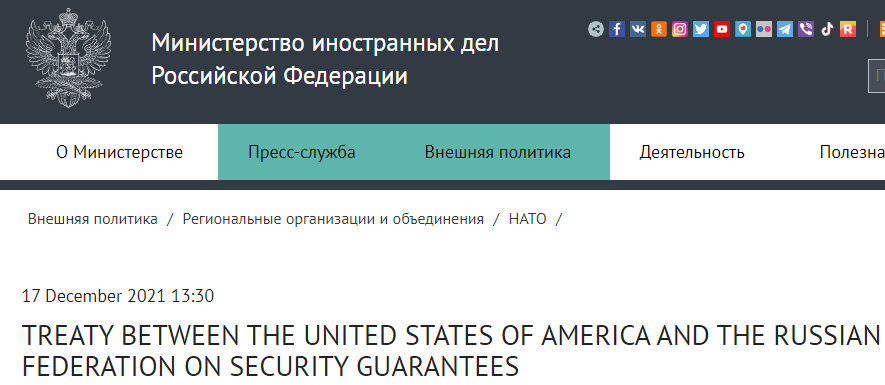
Articles 3, 6 and 7 make this point emphatically: “the Parties shall not use the territories of other States with a view to preparing or carrying out an armed attack against the other Party or other actions affecting core security interests of the other Party [Article 3]…. The Parties shall undertake not to deploy ground-launched intermediate-range and shorter-range missiles outside their national territories [Article 6]…The Parties shall not train military and civilian personnel from non-nuclear countries to use nuclear weapons. The Parties shall not conduct exercises or training for general-purpose forces, that include scenarios involving the use of nuclear weapons [Article 7].”
This break with the tactics of the Blin-Needle gang is unmistakeable and fundamental. If Biden, Burns, Austin, and Milley won’t agree, it is now for Chancellor Scholz to understand — and perhaps for Macron’s successors – the choice for nuclear war which the Americans are making.
In the proposed Russia-NATO treaty (note whose name comes first at the head of the paper), the Russians have included a reminder of what the NATO allies were all prepared to agree with President Boris Yeltsin on May 27, 1997. Article 4 of the new treaty says: “The Russian Federation and all the Parties that were member States of the North Atlantic Treaty Organization as of 27 May 1997, respectively, shall not deploy military forces and weaponry on the territory of any of the other States in Europe in addition to the forces stationed on that territory as of 27 May 1997.”

At the signing of the NATO-Russia pact in Paris, May 27, 1997 – left to right, front row: Turkish President Suleiman Demirel, President Bill Clinton, President Yeltsin, French President Jacques Chirac, NATO Secretary-General Javier Solana, Chancellor Helmut Kohl. Back row: Prime Minister Tony Blair, Greek Prime Minister Costas Simitis, Spanish Prime Minister José María Aznar, Romanian President Emil Constantinescu, Dutch Prime Minister Wim Kok, Austrian Chancellor Viktor Klima, and Italian Prime Minister Romano Prodi.
The reference is to the agreement known as the Founding Act – read what it said verbatim and also the qualifications and change of meaning introduced almost immediately.
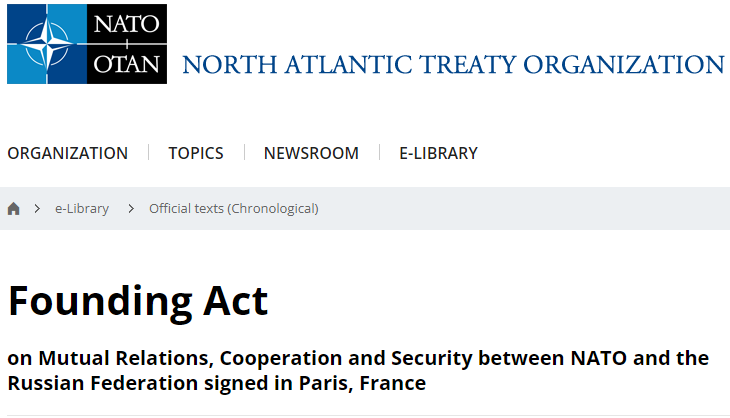
Source: https://www.nato.int/
By returning to that pact, the Kremlin is now telling the Germans and French to decide in public, not in secret, whether they are prepared to go to nuclear war with Russia over US plans to deploy nuclear-armed missiles in Germany, Romania, and Poland, and then nuclear-capable operations in Ukraine and the Baltic states. This is far from being a novel choice for the Europeans.
The new pact is a reminder of the terms which the US itself accepted in concluding the Cuban missile crisis in 1962 with reciprocal missile withdrawals – the Cuban-based Dvina and Chusovaya by Moscow, Turkish and Italian-based Jupiters by Washington — and then in the signing of the Intermediate-range Nuclear Forces (INF) Treaty of 1987: “Article 5 — The Parties shall not deploy land-based intermediate- and short-range missiles in areas allowing them to reach the territory of the other Parties”.
Articles 6 and 7 invite Germany to understand it cannot survive itself if it accepts US nuclear-capable arming of the Ukraine, the Black and Baltic Seas. “All member States of the North Atlantic Treaty Organization commit themselves to refrain from any further enlargement of NATO, including the accession of Ukraine as well as other States [Article 6]… The Parties that are member States of the North Atlantic Treaty Organization shall not conduct any military activity on the territory of Ukraine as well as other States in the Eastern Europe, in the South Caucasus and in Central Asia. In order to exclude incidents the Russian Federation and the Parties that are member States of the North Atlantic Treaty Organization shall not conduct military exercises or other military activities above the brigade level in a zone of agreed width and configuration on each side of the border line of the Russian Federation and the states in a military alliance with it, as well as Parties that are member States of the North Atlantic Treaty Organization [Article 7].” Click to read the second Russia-NATO treaty proposal.
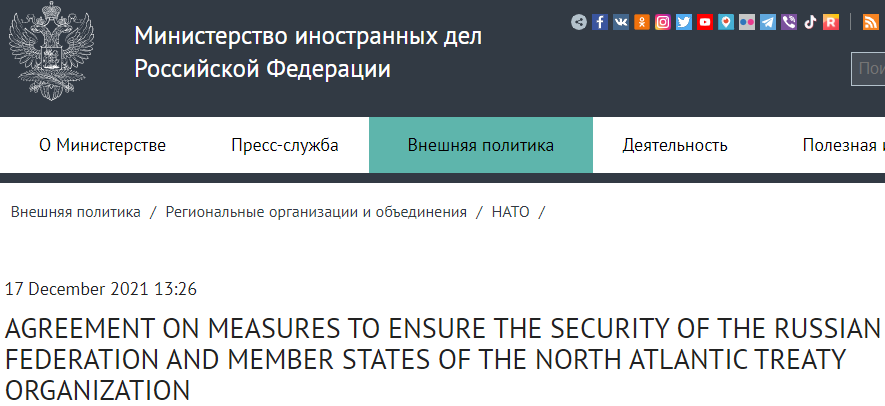
Under former chancellor Angela Merkel, the German government’s secret fabrications and public lying during the Navalny Novichok affair seriously damaged the reciprocal understandings required for Moscow and Berlin not to go to war with each other again. That was in large measure the intention and objective of the plan — just as it had been the intention and objective of the Skripal Novichok operation in the UK since 2018. The Kremlin is now trying publicly and secretly to ask the same questions of Scholz and his coalition.
In parallel, the Germans have been asked to watch as the Kremlin does its best, in the open and on videotape, to demonstrate President Biden’s capacity to decide differently from the Blin-Needle gang. This is the reason for this fresh Kremlin release of film of Putin’s preparations for the video summit with Biden ten days earlier, on December 7.
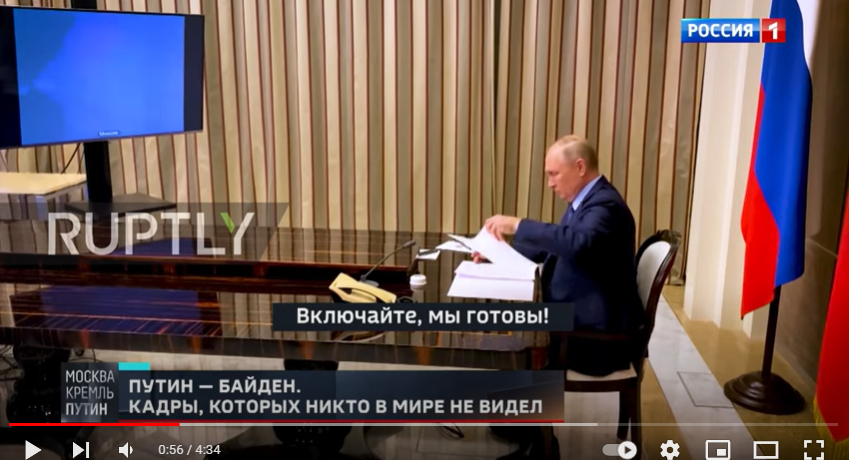
Source: https://www.youtube.com/
The commentary by Kremlin spokesman Dmitry Peskov emphasizes, not only Biden’s capacity to decide, but also the videotape record to prove exactly what was said in case the Blin-Needle gang publishes a different version.
And so the first question now tabled by the draft treaties is whether there is anyone on the US and NATO sides worth the Stavka talking to. The second question is whether the negotiations on the treaty terms can transform the public propaganda of the war which the Blin-Needle gang believes the Russians deserve – and they, if not other Americans and Germans, will survive.
When the Russian draft of the treaty with the US invites the sides to “[reaffirm] that a nuclear war cannot be won and must never be fought”, it’s a message to Berlin that this time round, not even the hangman will survive.
[* CORRECTION] In the story of Antony Blinken’s change of family name from its Ukrainian roots, the original name appears to signify the Jewish village of Blinki which has come under Russian, Soviet, and Ukrainian rule, and is now deserted. The village’s name, a diminutive, refers in Russian to the blin (блин) or pancake; for more detail, click to read this and this. “Nudelman”, the original family name in Ukraine of Victoria Nuland’s father and his family, identified their occupation as tailors. In English transliteration, nudel meant “needle” in Yiddish (נאָדל). Noodle in Yiddish is לאָקשן – lokshen. Here is Nuland’s father’s account of why he changed his name from Nudelman to Nuland. In April of this year, I was mistaken in a report to apply the German noodle, not the Yiddish needle for the etymology of the Nudelman name; the German for needle is nadel.











Leave a Reply